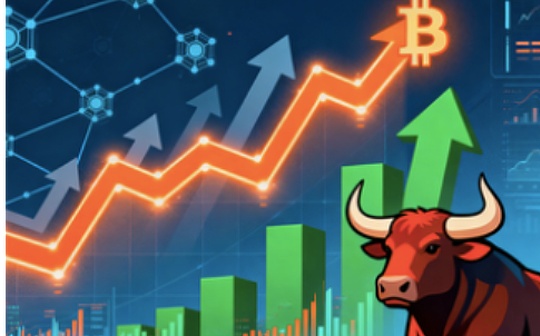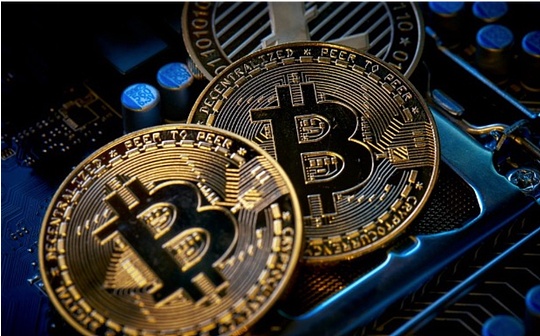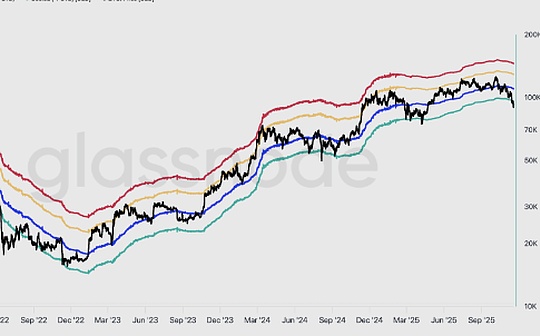
Original title:Light at the end of turmoil II
Author: Jordi Visser, Wall Street expert, author of Bitcoin’s Silent IPO; Compiled by: Bitcoin Vision
On April 8, when the panic over tariffs and Liberation Day was at its peak, I published an article on Substack titled “Light at the End of Turbulence I.”At that time, the S&P 500 index had fallen by 20%, economists were warning of recession, and the market was dominated by panic.I proposed in the article that this artificially induced sell-off will become an excellent buying opportunity-the core driver is AI, and six months later we will find that compared to the rapid development of AI, the initial panic is completely untenable.
In the end, it turned out to be exactly what I expected.The market bottomed out and rebounded, risk assets rebounded sharply, the AI narrative accelerated, and people gradually adapted to the new market environment.
Then in November, when the Bitcoin community fell into despair as the price of the currency was trading sideways and underperforming the stock market, I wrote “Bitcoin’s Silent IPO” article.I believe that Bitcoin’s sideways trading when other assets are rising is not a sign of weakness, but a necessary chip distribution stage.The early giant whales finally ushered in the opportunity to release liquidity. Taking advantage of the strong institutional buying brought by ETFs and corporate treasury, they methodically reduced their holdings and left the market.This is like the expiration of the lock-up period of a traditional IPO. The process is uncomfortable and requires patience, but in the long run it is crucial to the healthy development of the market.
Now, this sideways pattern has been broken.As the stock market (especially speculative AI concept stocks where retail investors gather) finally began to correct, the distribution of chips triggered by silent IPOs further exacerbated Bitcoin’s decline.I also highlighted this in my weekly video last weekend.The drop turned Bitcoin’s gains this year into slightly negative territory.The “cognitive dissonance” that previously frustrated the cryptocurrency community has now evolved into genuine bearishness and doubts.The optimism of the “Liberation Day” period seems to be a distant memory. Discussions about the “end of the four-year cycle” are intensifying. The argument that “Bitcoin has lost its upside potential” continues to echo on the X platform (formerly Twitter). Even those who insist that “this time is different” are beginning to surrender.
The decline brought the CoinMarketCap Crypto Fear and Greed Index to 15, which is the same as the lows seen around Liberation Day.All hope seemed lost.Because of this, it’s time to launch Light at the End of Turmoil II.Consistent with the core point of view during the “Liberation Day”, I still believe that the trend of all assets is driven by the development of AI – in the next few years, all investors will eventually realize that they have missed a narrative, and the purest AI narrative is Bitcoin.
The Bitcoin white paper was born almost at the same time as the 2009 research paper by Raina-Madhavan-Ng (the first groundbreaking study to prove that GPUs can increase the speed of deep learning by more than 70 times, thus opening the era of modern GPU-driven machine learning).Both are exponential innovations, and they complement each other and are indispensable.
Exponential innovation reduces people’s need for office work and even reduces overall employment demand to a certain extent.It exacerbates wealth inequality, forces governments around the world to run fiscal deficits, and drives up financial asset prices—essentially a form of “universal basic income” (UBI).Today’s UBI isn’t a check from the government, but a “universal beta benefit”: your wealth grows naturally because the system has no choice.For those without assets, government transfers would become another form of universal basic income.This has created the “K-shaped economy” that we often hear, and most people are angry because of the increased burden of life. They have to worry about the risk of unemployment, bear the salary pressure caused by reduced corporate recruitment, and face the inflation caused by the government’s “universal basic income” policy.Bitcoin stands to benefit from this spiral: it will remain relevant to risk assets until artificial intelligence begins to reshape capitalism and public markets.The combination of stablecoins and artificial intelligence agents will increase the velocity of currency and reduce the need for leverage; while asset tokenization will allow concentrated assets with low liquidity, such as real estate, private debt, private equity, and venture capital, to be freely traded 24 hours a day, 7×24 hours a day, thus reducing the amount of leverage required to support the prices of these assets.As artificial intelligence develops, its deflationary effect will gradually become apparent.In 2026, artificial intelligence drug research and development, self-driving taxis and artificial intelligence agents will drive corporate profit margins to increase. At the same time, competition caused by commercialized intelligence will accelerate, thereby driving up related asset prices.
The most interesting thing right now is this: People who were still complaining about Bitcoin’s failure to keep up with the stock market are now finally showing the performance they deserve.As the stock market (especially frothy retail AI concept stocks) corrected, Bitcoin fell simultaneously.The “divergence market” that confused everyone during the “silent IPO” period has ended.Bitcoin has returned to the attributes of a risky asset, and its trend is closely related to growth expectations and liquidity environment.In my opinion, this will accumulate the necessary purchasing power and momentum for a new upward trend.
This means,As I look ahead to the market landscape in 2026, I once again see “the light at the end of the turmoil.”Just as April’s tariff scare created buying opportunities for those who can penetrate the fear, this pullback triggered by Bitcoin’s synchronized weakness with overall risk assets is paving the way for the next wave of sharp gains.
Why is Bitcoin moving in tandem with the stock market a bullish sign?
A long-standing misconception is that Bitcoin should operate independently from traditional risk assets.The mainstream narrative believes that Bitcoin is digital gold, a tool to hedge risks in the existing system, and has nothing to do with the stock market.Therefore, if Bitcoin falls along with the stock market, it means “something is wrong.”
This view is wrong.Bitcoin is a risky asset.I made this point clearly in my Substack article “Yes, Virginia, Bitcoin is a Risky Asset.”
It is true that Bitcoin has value storage properties and has also achieved decentralization.But from the perspective of market psychology and capital flows, Bitcoin behaves more like a high-beta risky asset.ETF buyers will incorporate Bitcoin into their asset allocation along with stocks, and when they de-risk their portfolio, Bitcoin will be reduced simultaneously with stocks.Retail traders trade both cryptocurrencies and stocks with the same funds.Even those investors who are concerned about the devaluation of fiat currencies will be more active in accumulating Bitcoin during periods of strong economic strength and abundant cash flow.
Therefore, when the Nasdaq index falls, Bitcoin will fall with it; when AI concept stocks suffer setbacks, Bitcoin will also be affected.This isn’t a flaw, it’s a feature — and it makes perfect sense given Bitcoin’s holder structure.
The reason why this is a bullish signal is that if Bitcoin moves in tandem with risk assets, then the outlook for Bitcoin is closely tied to the outlook for risk assets.This means that to understand the future of Bitcoin, we first need to understand where the stock market is headed.
Next I will explain why I am extremely optimistic about the outlook for risk assets in 2026.
Market structure in 2026: triple resonance of finance, currency and AI
Markets always rise on worries.Current worries mainly stem from concerns about AI bubbles, recession expectations and cryptocurrency pessimism, but the market layout in 2026 is extremely attractive.
Financial support continues to be provided.The Infrastructure Act, Chip and Science Act, and Inflation Reduction Act are not empty political slogans, but trillions of dollars in spending plans that are creating real economic activity and maintaining fiscal deficits.The “Big Beautiful Act” is preparing for the mid-term elections in advance. Data centers are being built at an unprecedented speed, semiconductor factories are being built one after another, and power infrastructure is also being upgraded.
The Fed has room to ease.Inflation is currently within a controllable range, and wages, housing prices and oil prices are all under pressure this year. Therefore, even if the impact of tariffs gradually emerges, combined with the weakness of the labor market, inflation levels will remain stable.Artificial intelligence is both a deflationary force and can exacerbate labor market weakness.
AI breakthroughs are coming.Artificial intelligence has developed at an astonishing pace over the past year.And in the near future, we will witness tangible, real-world-changing breakthroughs that will attract mainstream attention:
-
Artificial intelligence drug development: The first drugs discovered by AI are approaching the clinical trial stage.Once positive news comes, its impact on the healthcare industry and economic productivity will be profound.As of November, pharmaceutical stocks have had their best relative earnings month in 30 years. Every pharmaceutical company will be scrambling to integrate AI into the R&D process, and billions of dollars will flow into the AI medical field.
-
Self-driving cars: After years of “five years away” predictions, we’re finally reaching an inflection point.Waymo is expanding its scope of operations, Tesla’s fully self-driving (FSD) technology continues to iterate, and Chinese companies are also deploying self-driving taxis on a large scale.In 2026, when self-driving cars become popular in major cities, speculation about humanoid robots will explode.
-
AI Agents and Productivity Improvements: AI agents capable of autonomously performing complex tasks will become ubiquitous in various fields – enterprise software, customer service, creative industries, etc.This will bring huge productivity gains to the entire economy and boost corporate profit margins.Artificial intelligence makes all businesses more efficient, more productive, and more profitable.
Manufacturing is expanding.A boom in building artificial intelligence infrastructure is driving a resurgence in U.S. manufacturing.The manufacturing sector is showing signs of recovery after years of contraction.I believe that the Purchasing Managers Index (PMI) will pick up in 2026, driven by the multiple catalysts mentioned above.Historically, cryptocurrencies (especially altcoins) tend to perform extremely well when PMI rises.
The bears will cry “the AI bubble is about to burst!” And maybe it is.But the duration and rise of bubbles often exceed everyone’s expectations.The dot-com bubble didn’t burst in 1997, when valuations first showed signs of being outrageous, but it peaked three years later, in March 2000.From the end of 1994 to the end of 1999, the Nasdaq 100 Index (known as QQQ) rose by 800%, while the QQQ rose by less than 100% in the past five years.Compared with the Internet bubble, the current AI boom is not a bubble at all.Even if we are in an AI bubble, we are only in the early to mid-stage stages – the mainstream crowd is not yet fully involved, your relatives will not ask about AI stocks at Thanksgiving dinner, and this scene often occurs in the later stages of the bubble, and I believe that cryptocurrencies will follow a similar pattern.
In addition,Bubbles need a catalyst to burst, usually the Federal Reserve aggressively raising interest rates when the economy weakens.However, the Federal Reserve has completed this cycle of interest rate hikes and may adopt easing policies in 2026 instead of starting a new interest rate hike cycle.There is currently no typical catalyst for a bubble to burst.
Bitcoin’s Core Catalysts in 2026
If risk assets perform strongly in 2026, Bitcoin, a high-beta risk asset, should outperform significantly.The following Bitcoin-specific catalysts make its rise layout more attractive.
Clarity Act.Regulatory uncertainty has been a drag on the cryptocurrency market for years.The Cryptocurrency Clarity Act, which is expected to be passed by the end of 2025 or early 2026, will provide a clear regulatory framework, clarify jurisdiction, and eliminate legal ambiguities that deter institutional investors.The “waiting for regulatory clarity” camp, including some of the largest asset managers and pension funds, will eventually be allowed to enter the market.At that point, the ETF inflows we are seeing now will pale in comparison to the torrent of funds to come.
The scale of asset tokenization is expanding.Large financial institutions are advancing the tokenization process of treasury bonds, real estate, commodities and stocks.Institutions such as JPMorgan Chase, BlackRock, and Franklin Templeton are all building tokenization platforms.This validates the value of the entire cryptocurrency infrastructure and proves that blockchain is not just for “digital gold.”As the scale of tokenization expands, assets with low liquidity begin to trade 24/7 and leverage requirements decrease, Bitcoin’s role as a neutral settlement asset will become increasingly prominent, becoming the “Transmission Control Protocol/Internet Protocol (TCP/IP)” in the field of digital finance.
The popularity of stablecoins is accelerating.This is the most underrated bullish factor.Global adoption of stablecoins is exploding, especially in developing countries.Tether and USDC are becoming dollar payment conduits for large swathes of the global economy: when Nigerians receive USDC as payment instead of naira, when Argentinian businesses hold dollar-denominated stablecoins instead of pesos, when cross-border payments are made through stablecoins instead of correspondent banks, cryptocurrency infrastructure has become an integral part of global trade.
Stablecoins and Bitcoin are not competitors, but a binary system.Stablecoins act as a medium of exchange for the digital economy, while Bitcoin acts as a store of value.As more economic activity and funds flow into the digital economy, a significant portion of them will naturally flow into Bitcoin.You can think of stablecoins as the broad money supply (M2) of the digital world, and tokenization is the bridge to introduce traditional fiat assets into the system.This will create a powerful network effect: the popularity of stablecoins will bring millions of new users into the cryptocurrency ecosystem. After these users leave stablecoins, they will eventually need a long-term value storage channel, and Bitcoin will become the default choice.The network effect brought about by the growth of stablecoins will accelerate the popularity of Bitcoin in a way that is difficult to quantify but cannot be ignored.
Historical pattern repeats itself
Decades of market experience have taught me this: Initial lows tend to be retested.We saw this in April – the market bottomed, rebounded, then retested the lows, and then started a sharp rise.This is a normal and healthy pattern for the market to build support and purge weak holders.
I expect Bitcoin may follow a similar path.We may well have reached an initial low, but a retest of that low is still possible in the coming weeks.As the last weak holders capitulate, there could be another wave of selling or even a “final purge” that briefly pushes Bitcoin to even lower levels.
If a retest of the lows occurs, it will be a great opportunity for the year.Because during the low retest process, smart money that missed the first bottom will get a second chance to enter.Retesting the lows when trading volume shrinks and panic weakens will confirm that the initial low is the real bottom.However, I don’t recommend waiting for lows and retesting – I think the current range between Bitcoin and the stock market is an ideal time to seize opportunities when fear is high and greed is low.
Bitcoin has been on a downward trend this year, and the early whale holding reductions triggered by the “silent IPO” may not have completely ended, but significant progress has been made.The holding structure of Bitcoin is more dispersed than ever before. Retail investors are bearish and leaving the market, ETF buyers are patiently increasing their holdings, and investors worried about the devaluation of legal currencies continue to systematically increase their positions. Developing countries are steadily adopting Bitcoin as financial infrastructure.
At the same time, the market layout in 2026 is excellent: fiscal support continues to be strong, monetary policy provides assistance, breakthroughs in artificial intelligence will drive speculation and actual profit growth, manufacturing is expanding, the Cryptocurrency Clarity Act will bring regulatory certainty, asset tokenization will expand, and the popularity of stablecoins will strengthen network effects.
Bitcoin has moved in tandem with risk assets, which are primed for strong performance in 2026.Therefore, Bitcoin also has the foundation for a sharp rise in 2026.
Dawn is ahead
I always think back to the scene during the “Liberation Day” period: the S&P 500 dropped 20%, economists warned of recession, and people panic-sold.I suggested at the time that looking back six months from now, we would see that the initial panic was unfounded.It turns out I was right.
Today, I feel the same way about Bitcoin.Admittedly, this pullback has been painful, and market sentiment has been extremely bad, with the Fear and Greed Index falling to 15, which is the same as the “Liberation Day” low.But a correction in a bull market always makes people feel like the end of the world is coming, always makes people feel that “this time is different”, always makes people believe that the uptrend is over.
But for those who can penetrate the fear, these pullbacks are always buying opportunities.
I have lived through countless crises in my trading career—the 1994 Mexican financial crisis, the 1998 Brazilian financial crisis, the global financial crisis, COVID-19, the Liberation Day scare—and I know that these unsettling moments are never as scary as they seem.One core truth remains the same: If you can get past fear, these moments will lead to the best investment opportunities.
Bitcoin is not collapsing, and digital assets are not dying.Everything that is happening now is what is supposed to happen: a maturing risk asset that is still recovering from the cold winter of 2022, and is currently experiencing uncertainty and position adjustments, and is pulling back simultaneously with other risk assets.Unlike April, this pullback is narrower and focused on growth stocks and cryptocurrencies rather than a full-scale market panic. This is healthier and means that the market is pricing differentially. It also means that when the recovery comes, the rise may be faster and more targeted.
For those who can discern opportunity, now is the time to accumulate.It’s not about adding positions recklessly, adding leverage, or investing money you can’t afford to lose. It’s about making prudent and firm decisions based on fundamentals and beliefs.
In the context of AI-driven investment excess returns, the market will be volatile.As governments face many challenges in dealing with this disruptive force, there will inevitably be frightening moments ahead, doubts will persist, and media headlines will be filled with noise about crashes and bear markets.Ignore the noise and focus on the fundamentals: Artificial Intelligence is the most important and powerful innovation we have witnessed in our lifetime, and it will bring us better days in the years to come.
When everyone sees the light, it will be too late to make plans.Today, the fear and greed index in the cryptocurrency market is as low as 15, market participants are capitulating, and the tunnel remains dark—but the opportunity is now.
Six months from now, just like on Liberation Day, Bitcoin’s market narrative will be very different.When we look back at current prices and sentiment, we can’t help but wonder: Why did we have doubts in the first place?
The dawn is already there.You just have to be willing to see it.








